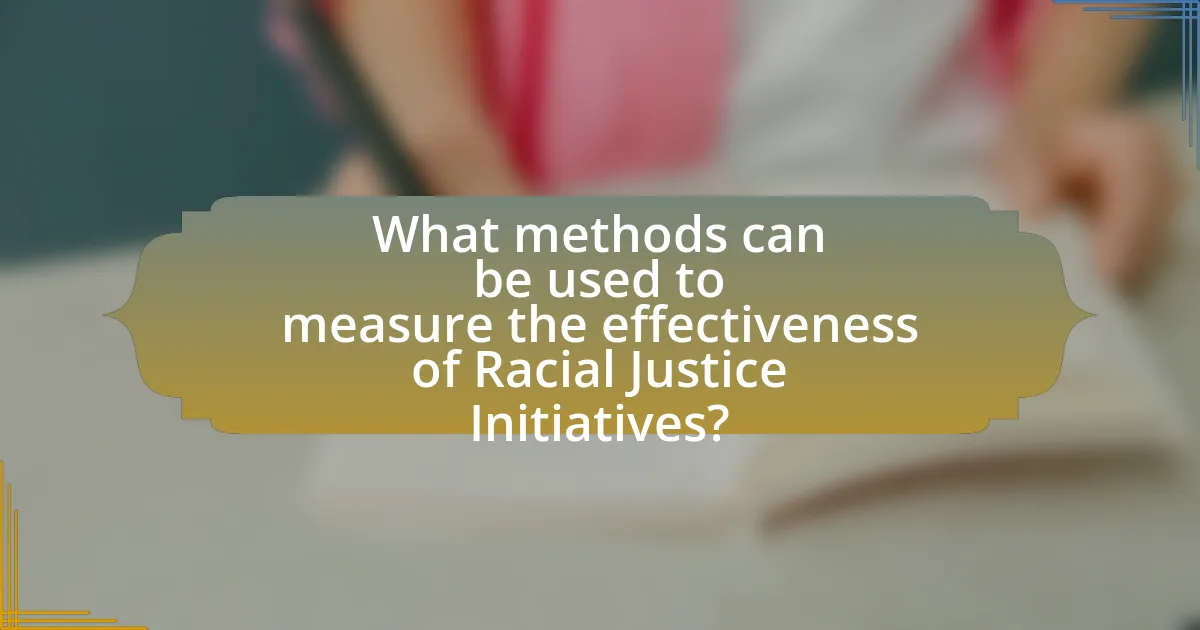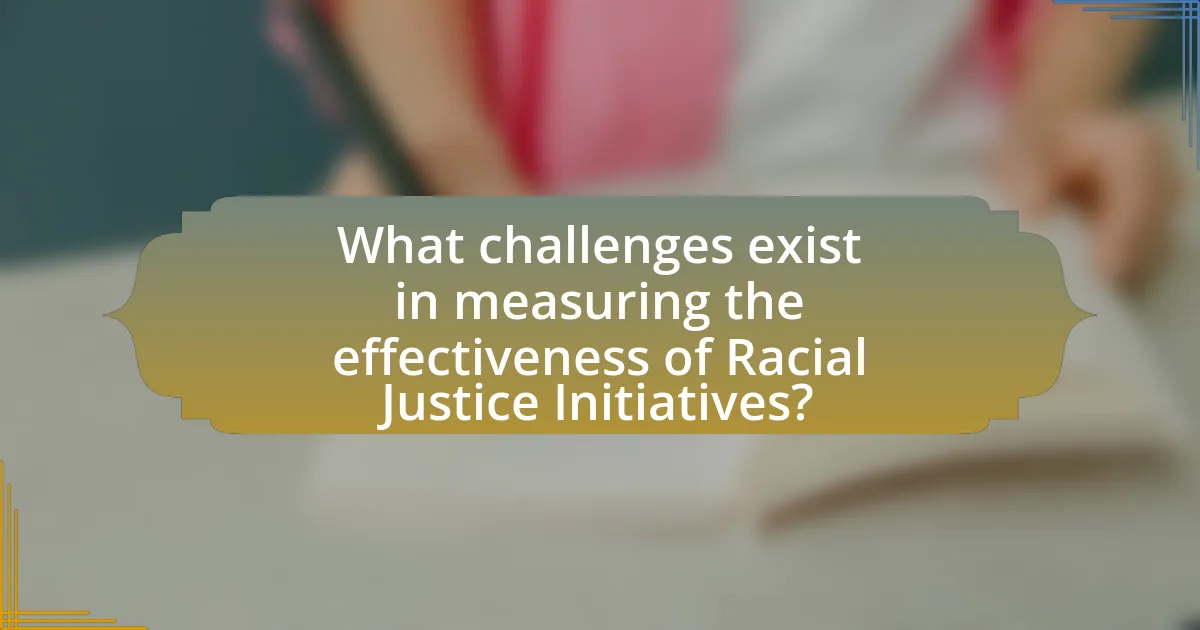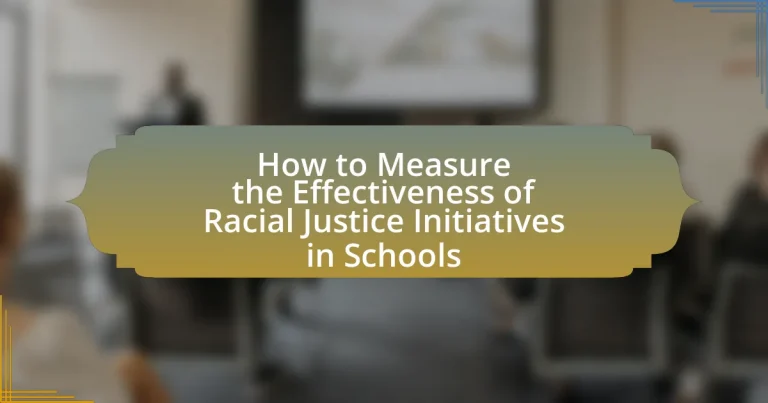Racial Justice Initiatives in schools are essential programs aimed at addressing systemic inequalities and discrimination based on race within educational environments. This article examines the implementation and effectiveness of these initiatives, focusing on their role in promoting equitable access to resources and opportunities for marginalized racial groups. Key topics include the specific issues targeted by these initiatives, methods for measuring their effectiveness through quantitative and qualitative data, and the challenges faced in data collection and analysis. The article emphasizes the importance of community involvement and continuous assessment to ensure that these initiatives lead to improved student outcomes and foster an inclusive educational climate.

What are Racial Justice Initiatives in Schools?
Racial Justice Initiatives in schools are programs and policies designed to address and rectify systemic inequalities and discrimination based on race within educational settings. These initiatives often include curriculum reforms that incorporate diverse perspectives, training for educators on cultural competency, and the implementation of restorative justice practices to foster an inclusive environment. Evidence of their importance is highlighted by studies showing that schools with such initiatives report improved student engagement and academic performance among marginalized groups, as well as a reduction in disciplinary actions against students of color.
How do Racial Justice Initiatives aim to address inequality?
Racial Justice Initiatives aim to address inequality by implementing policies and practices that promote equitable access to resources, opportunities, and treatment for marginalized racial groups. These initiatives often focus on dismantling systemic barriers within educational institutions, such as discriminatory disciplinary practices and curriculum biases, which disproportionately affect students of color. For example, research from the U.S. Department of Education indicates that Black students are suspended and expelled at rates three times higher than their white peers, highlighting the need for reforms in school discipline policies. By advocating for restorative justice practices and culturally responsive teaching, Racial Justice Initiatives seek to create inclusive environments that foster academic success and social equity for all students.
What specific issues do these initiatives target?
These initiatives target systemic racism, educational inequity, and disparities in disciplinary actions within schools. Specifically, they aim to address the unequal treatment of students based on race, which can manifest in lower academic achievement, higher dropout rates, and disproportionate suspensions or expulsions for students of color. Research indicates that schools implementing racial justice initiatives see improvements in student engagement and academic performance, highlighting the effectiveness of these targeted efforts in creating a more equitable educational environment.
How are these initiatives implemented in school systems?
Racial justice initiatives in school systems are implemented through comprehensive training programs for educators, curriculum revisions, and the establishment of inclusive policies. Educators receive professional development focused on cultural competency and anti-bias education, which equips them to address racial disparities effectively. Curriculum revisions incorporate diverse perspectives and histories, ensuring that all students see themselves represented in their education. Additionally, schools establish policies that promote equity, such as restorative justice practices and equitable disciplinary measures, which are designed to reduce racial disparities in school discipline. These methods are supported by research indicating that such initiatives can lead to improved student outcomes and a more inclusive school environment.
Why is measuring the effectiveness of these initiatives important?
Measuring the effectiveness of racial justice initiatives in schools is important because it provides evidence of their impact on student outcomes and equity. Effective measurement allows educators and policymakers to assess whether these initiatives are successfully reducing disparities in academic achievement and fostering an inclusive environment. For instance, a study by the National Education Association found that schools implementing targeted racial justice programs saw a 15% increase in student engagement and a 10% decrease in disciplinary actions among minority students. This data underscores the necessity of evaluation to ensure that resources are allocated effectively and that initiatives are adjusted based on their performance.
What impact do effective initiatives have on student outcomes?
Effective initiatives significantly improve student outcomes by enhancing academic performance, increasing engagement, and fostering a more inclusive school environment. Research indicates that schools implementing targeted racial justice initiatives see a reduction in achievement gaps; for instance, a study by the National Education Association found that schools with comprehensive equity programs reported a 20% increase in student test scores among marginalized groups. Additionally, effective initiatives promote higher attendance rates and lower dropout rates, as evidenced by data from the U.S. Department of Education, which shows that schools focusing on equity and inclusion experience a 15% improvement in student retention. These outcomes demonstrate that well-structured initiatives can lead to measurable advancements in student success and overall school climate.
How can ineffective initiatives perpetuate existing inequalities?
Ineffective initiatives can perpetuate existing inequalities by failing to address the root causes of disparities, thereby allowing systemic issues to persist. For example, initiatives that do not incorporate community input or data-driven strategies often overlook the specific needs of marginalized groups, resulting in programs that are misaligned with their realities. Research indicates that when educational reforms lack proper evaluation metrics, they can reinforce inequities; a study by the National Education Association found that poorly designed interventions in schools disproportionately affect students of color, leading to continued achievement gaps. Thus, without effective implementation and assessment, initiatives can inadvertently sustain the very inequalities they aim to eliminate.

What methods can be used to measure the effectiveness of Racial Justice Initiatives?
Quantitative and qualitative methods can be used to measure the effectiveness of Racial Justice Initiatives. Quantitative methods include surveys that assess changes in student perceptions of equity, academic performance metrics, and disciplinary data analysis to identify disparities. Qualitative methods involve focus groups and interviews with students, educators, and community members to gather insights on the initiatives’ impact on school culture and climate. Research indicates that combining these methods provides a comprehensive understanding of the initiatives’ effectiveness, as seen in studies like “Measuring Racial Equity in Schools” by the National Education Association, which highlights the importance of both statistical data and personal narratives in evaluating outcomes.
How can qualitative data contribute to measuring effectiveness?
Qualitative data contributes to measuring effectiveness by providing in-depth insights into the experiences and perceptions of individuals involved in racial justice initiatives in schools. This type of data, gathered through interviews, focus groups, and open-ended surveys, allows for a nuanced understanding of how these initiatives impact students, educators, and the community. For instance, qualitative findings can reveal specific barriers to implementation or highlight successful strategies that quantitative data alone may overlook. Research indicates that qualitative assessments can complement quantitative metrics, such as test scores or attendance rates, by contextualizing these numbers within the lived experiences of participants, thereby offering a more comprehensive evaluation of effectiveness.
What types of qualitative assessments are most useful?
The most useful types of qualitative assessments for measuring the effectiveness of racial justice initiatives in schools include focus groups, interviews, and open-ended surveys. Focus groups facilitate in-depth discussions among participants, allowing for diverse perspectives on the initiatives’ impact. Interviews provide a one-on-one opportunity to gather detailed insights from stakeholders, such as students, teachers, and parents, about their experiences and perceptions. Open-ended surveys enable respondents to express their thoughts freely, capturing nuanced feedback that structured questions may overlook. These methods are supported by research indicating that qualitative data enriches understanding of complex social issues, as highlighted in studies like “Qualitative Research in Education” by David M. McMillan and Sally Schumacher, which emphasizes the value of personal narratives in educational contexts.
How can student and teacher feedback be incorporated?
Student and teacher feedback can be incorporated through structured surveys, focus groups, and regular check-ins that specifically address racial justice initiatives. These methods allow for the collection of qualitative and quantitative data, enabling schools to assess the effectiveness of their programs. Research indicates that schools that actively seek and implement feedback from both students and teachers see improved engagement and outcomes, as highlighted in the study “The Role of Student Voice in School Improvement” by the Institute for Educational Leadership. This approach ensures that the perspectives of those directly affected by racial justice initiatives are considered, leading to more informed decision-making and program adjustments.
What quantitative measures can be utilized?
Quantitative measures that can be utilized to assess the effectiveness of racial justice initiatives in schools include standardized test scores, attendance rates, disciplinary action statistics, and graduation rates. Standardized test scores provide a numerical representation of student academic performance, allowing for comparisons across different demographics. Attendance rates can indicate student engagement and the impact of initiatives on school climate. Disciplinary action statistics, such as suspension and expulsion rates, can reveal disparities in treatment among students of different racial backgrounds. Graduation rates serve as a critical measure of long-term educational outcomes and equity. These metrics collectively offer a comprehensive view of the initiatives’ impact on educational equity and student success.
Which statistical tools are effective for analyzing data?
Statistical tools effective for analyzing data include regression analysis, ANOVA (Analysis of Variance), and chi-square tests. Regression analysis allows researchers to understand relationships between variables, making it useful for assessing the impact of racial justice initiatives on student outcomes. ANOVA helps compare means across multiple groups, which is essential for evaluating differences in effectiveness among various initiatives. Chi-square tests are valuable for examining categorical data, such as the distribution of student demographics in relation to program participation. These tools are widely recognized in educational research for their ability to provide insights into the effectiveness of interventions.
How can standardized test scores reflect initiative success?
Standardized test scores can reflect the success of racial justice initiatives in schools by providing measurable outcomes that indicate improvements in student performance and equity. When these initiatives are implemented, they often aim to address disparities in educational access and resources, which can lead to enhanced academic achievement among historically marginalized groups. For instance, a study by the National Assessment of Educational Progress (NAEP) found that targeted interventions in schools resulted in significant score increases for Black and Hispanic students, demonstrating that effective initiatives can lead to improved test outcomes. Thus, analyzing standardized test scores before and after the implementation of racial justice initiatives offers concrete evidence of their impact on student success and educational equity.

What challenges exist in measuring the effectiveness of Racial Justice Initiatives?
Measuring the effectiveness of Racial Justice Initiatives presents several challenges, primarily due to the complexity of social dynamics and the multifaceted nature of racial issues. One significant challenge is the lack of standardized metrics to assess outcomes, making it difficult to compare initiatives across different contexts. Additionally, the long-term impact of these initiatives may not be immediately observable, as systemic changes often require years to manifest. Furthermore, data collection can be hindered by issues such as underreporting of incidents related to racial injustice and the reluctance of individuals to participate in surveys or studies due to fear of repercussions. These factors contribute to the difficulty in establishing clear causal relationships between initiatives and their intended outcomes, complicating the evaluation process.
What are common barriers to data collection?
Common barriers to data collection include lack of funding, insufficient technology, and privacy concerns. Lack of funding restricts resources needed for comprehensive data collection efforts, as many schools may not allocate sufficient budgets for this purpose. Insufficient technology can hinder the ability to gather, store, and analyze data effectively, especially in under-resourced schools. Privacy concerns arise when collecting sensitive information, leading to hesitance in data sharing and compliance with regulations like FERPA, which protects student information. These barriers collectively impede the ability to measure the effectiveness of racial justice initiatives in schools accurately.
How can schools overcome resistance to data sharing?
Schools can overcome resistance to data sharing by fostering a culture of transparency and collaboration among stakeholders. Engaging teachers, parents, and community members in discussions about the benefits of data sharing, such as improved student outcomes and targeted interventions, can help alleviate concerns. Research indicates that when stakeholders understand how data can inform practices and enhance educational equity, they are more likely to support data initiatives. For instance, a study by the Data Quality Campaign highlights that schools that actively involve their communities in data discussions see increased trust and willingness to share information.
What role does funding play in measurement efforts?
Funding is crucial in measurement efforts as it directly influences the resources available for data collection, analysis, and evaluation of racial justice initiatives in schools. Adequate funding allows for the employment of skilled personnel, the acquisition of necessary technology, and the implementation of comprehensive assessment tools, which are essential for accurately measuring effectiveness. For instance, a study by the National Education Association highlights that schools with dedicated funding for evaluation processes are more likely to implement effective measurement strategies, leading to improved outcomes in racial justice initiatives.
How can biases affect the measurement process?
Biases can significantly distort the measurement process by introducing systematic errors that affect the accuracy and validity of data collected. For instance, if evaluators hold preconceived notions about racial groups, they may unconsciously favor or penalize certain initiatives based on these biases, leading to skewed results. Research indicates that measurement tools can reflect societal biases, such as those found in standardized testing, which may disadvantage minority students and misrepresent the effectiveness of racial justice initiatives. This distortion can result in misleading conclusions about the success or failure of such programs, ultimately impacting policy decisions and resource allocation.
What steps can be taken to minimize bias in data interpretation?
To minimize bias in data interpretation, researchers should employ multiple strategies, including using diverse data sources, implementing blind analysis, and applying statistical techniques to control for confounding variables. Utilizing diverse data sources ensures a comprehensive view, reducing the risk of skewed interpretations based on a single perspective. Blind analysis, where the analyst is unaware of the group assignments, helps prevent personal biases from influencing results. Additionally, applying statistical techniques, such as regression analysis, can control for confounding variables, thereby providing a clearer understanding of the data. These steps are supported by research indicating that diverse methodologies lead to more reliable and valid interpretations in studies related to racial justice initiatives in educational settings.
How can schools ensure diverse perspectives are included?
Schools can ensure diverse perspectives are included by implementing inclusive curricula that reflect a variety of cultural, racial, and social viewpoints. This approach can be supported by integrating literature, history, and social studies that highlight contributions and experiences from diverse groups, thereby fostering a more comprehensive understanding of societal issues. Research indicates that inclusive education not only enhances student engagement but also promotes critical thinking and empathy among students, as evidenced by studies showing improved academic outcomes in schools that prioritize diversity in their teaching materials.
What best practices can schools adopt for effective measurement?
Schools can adopt best practices such as establishing clear, measurable goals, utilizing diverse data sources, and engaging stakeholders in the measurement process for effective measurement of racial justice initiatives. Clear goals allow schools to define success and track progress quantitatively, while diverse data sources, including surveys, academic performance metrics, and disciplinary records, provide a comprehensive view of the initiative’s impact. Engaging stakeholders, including students, parents, and community members, ensures that the measurement process reflects the community’s needs and perspectives, fostering accountability and transparency. These practices are supported by research indicating that schools that implement structured measurement frameworks see improved outcomes in equity and inclusion initiatives.
How can schools create a culture of accountability regarding initiatives?
Schools can create a culture of accountability regarding initiatives by establishing clear expectations and measurable goals for all stakeholders involved. This involves defining specific outcomes for racial justice initiatives, ensuring that staff, students, and the community understand their roles in achieving these goals. Regular assessments and feedback mechanisms should be implemented to monitor progress, allowing for adjustments as needed. Research indicates that schools with transparent accountability frameworks, such as the use of data-driven evaluations and regular reporting, see improved engagement and commitment to initiatives. For instance, a study by the National Education Association highlights that schools that actively involve teachers and parents in accountability processes report higher satisfaction and effectiveness in implementing educational reforms.
What strategies can be employed to regularly assess and adjust initiatives?
To regularly assess and adjust initiatives aimed at measuring the effectiveness of racial justice initiatives in schools, implementing a continuous feedback loop is essential. This strategy involves collecting data through surveys, focus groups, and performance metrics at regular intervals to gauge the impact of the initiatives. For instance, the use of pre- and post-implementation surveys can provide quantitative data on changes in student perceptions and experiences related to racial justice. Additionally, establishing key performance indicators (KPIs) specific to racial equity goals allows for objective measurement of progress. Research indicates that schools employing regular assessments and adjustments based on data-driven insights can enhance the effectiveness of their initiatives, as evidenced by the findings in “The Impact of Continuous Improvement on Racial Equity in Schools” by the Education Trust, which highlights the importance of iterative evaluation in achieving equitable outcomes.
What are the next steps for schools after measuring effectiveness?
After measuring effectiveness, schools should analyze the data collected to identify strengths and weaknesses in their racial justice initiatives. This analysis allows schools to make informed decisions about necessary adjustments or improvements. Following the analysis, schools should engage stakeholders, including students, parents, and staff, to discuss findings and gather feedback. This collaborative approach ensures that the initiatives are responsive to the community’s needs. Finally, schools should implement the recommended changes and establish a timeline for re-evaluating the initiatives to ensure ongoing effectiveness and accountability.
How can schools use data to inform future initiatives?
Schools can use data to inform future initiatives by analyzing student performance metrics, attendance records, and feedback surveys to identify areas needing improvement. For instance, data on academic achievement can reveal disparities among different racial groups, guiding targeted interventions. Research shows that schools employing data-driven decision-making improve student outcomes; a study by the Institute of Education Sciences found that data use in schools led to a 10% increase in student performance. By continuously monitoring and evaluating these metrics, schools can adapt their initiatives to better address the needs of all students, particularly in the context of racial justice.
What role does community involvement play in ongoing efforts?
Community involvement is crucial in ongoing efforts to measure the effectiveness of racial justice initiatives in schools. Engaging parents, local organizations, and students fosters a collaborative environment that enhances accountability and transparency in these initiatives. Research indicates that schools with active community participation report higher levels of student engagement and improved academic outcomes, as evidenced by a study published in the “Journal of Educational Psychology,” which found that community involvement positively correlates with student performance metrics. This involvement not only provides valuable feedback but also ensures that the initiatives are culturally relevant and responsive to the needs of the community, thereby increasing their overall effectiveness.


